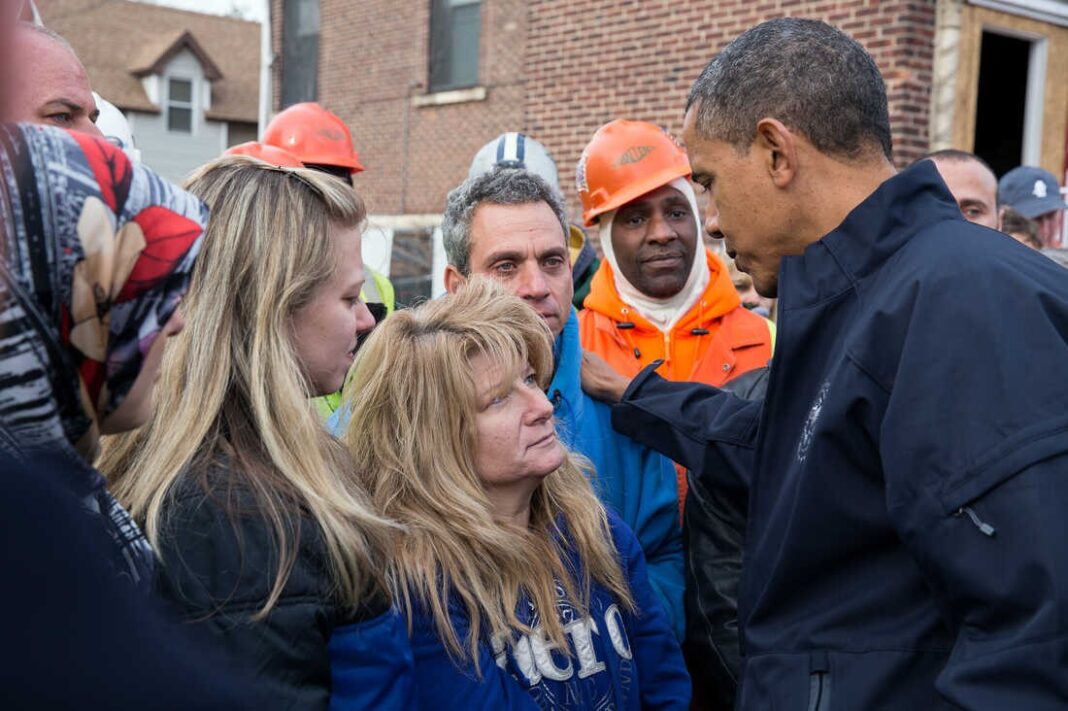
In 2012, Superstorm Sandy ravaged the U.S. East Coast, leaving devastation in its wake. But what followed was more revealing than the storm itself, a slow, painful unravelling of a system meant to help but rigged to profit. The Business of Disaster, a powerful investigative documentary by FRONTLINE and NPR, investigates the hidden truth of disaster capitalism in America under the guise of disaster management, showing how private companies, insurance firms, and government agencies turned tragedy into a business opportunity.
President Barack Obama[The Then] himself visited Staten Island, affected by the flood, which raised the hopes of a lot of the residents, thinking they would receive help and be back in their homes soon. The President put his arms around Diane Camerada while telling her that he’ll take care of it. However, three years later, they were still living in a wrecked house with sandy stormwater in their fish tank.
The heart of the documentary is the National Flood Insurance Program (NFIP), managed by FEMA, a federal program designed to assist homeowners with flood recovery. Business of Disaster reveals that private insurance companies administering the claims were pocketing huge fees, millions in profits, while victims were left stranded.

Those companies bore no financial risk but were paid a third of the collected premiums, totalling around $400 million after Sandy. Meanwhile, countless homeowners like Doug Quinn were denied fair compensation. Engineers hired to inspect damaged homes often never visited the site, while reports were manipulated to reduce payouts. The very system built to support disaster victims became a mechanism for corporations to grow richer—turning human loss into lucrative business.
Doug Quin expressed his frustration as, “It makes me angry to watch the way people are profiting unfairly on other people’s misery”.
Business of Disaster also highlights the failure of New York City’s Build It Back program. Despite receiving billions in federal aid, the recovery process was plagued by inefficiency, mismanagement, and profiteering. Unqualified caseworkers were hired at high wages, consultants earned high fees, and families were forced to wait years for assistance—if they got any at all. Neighbourhoods were unevenly rebuilt. Some homes were raised, others ignored. Paperwork was lost; decisions were delayed, and trust in the government crumbled.
Relating to this slow Bureaucratic process, one of the interviewees said, “I saw that we as NYC, with all the best intentions, created a big, hard-to-understand, bureaucratic, slow, inefficient process for getting people funds or getting them back to their homes.”
This dysfunction wasn’t just technical; it was political. It exposed how aid is distributed unequally, how poor communities are left to fend for themselves, and how bureaucracy often becomes a barrier rather than a bridge. One must think about where exactly funds are being utilised. Are they sitting on an insurance officer’s coffee table in the form of an expensive antique, or are they paying for someone’s vacation abroad? Are they draped around a woman’s neck in the form of pearls?
Business of Disaster doesn’t stop at policy critique; it shows a deeper, darker pattern. When natural disasters hit, they don’t just reveal cracks in buildings; they expose cracks in society, showing us exactly how tactful, ludicrous, and heinous humans can be.
Those with privilege, connections, legal support, and financial backing often recover. But working-class families, immigrants, and marginalized groups face endless delays, denials, and displacement. It also shows how private interests, insurance companies, lobbyists, and consultants use disasters as an opportunity to secure public funds for private gain, shaping legislation and response systems to benefit themselves.
Perhaps the most haunting reflection this documentary offers lies between the lines: if this level of fraud, inefficiency, and exploitation is happening in a developed country like the U.S., what must be happening in third-world countries?
As climate change increases the frequency and severity of natural disasters, particularly in vulnerable regions like South Asia, Sub-Saharan Africa, and Latin America, many of these nations rely heavily on foreign aid and international disaster relief.
Nevertheless, without strong governance, oversight, or accountability, aid can be easily misused, misdirected, or monopolized by corrupt elites or foreign contractors. If the U.S., with all its institutions, cannot protect its citizens from disaster capitalism, what hope do developing countries have?
The Business of Disaster is more than a documentary; it is a warning. It urges us to question who benefits when tragedy strikes and whether systems meant to offer relief have become tools of exploitation.
As climate disasters become the new norm, the need for transparent, equitable, and humane recovery systems is more urgent than ever. Whether in the streets of Staten Island or the floodplains of Sindh, people deserve more than hollow promises and profit-driven aid—they deserve justice.
References:
https://www.pbs.org/wgbh/frontline/documentary/business-of-disaster/transcript/
More from this Author: Death, Resilience, and Hope: A Review of “As Long As the Lemon Trees Grow

Khadija Tariq is a genetics graduate who loves understanding how diseases work at the molecular level and how we can use that knowledge to create better treatments. She was an intern at Scientia Pakistan Science Writing Internship Cohort Three.
